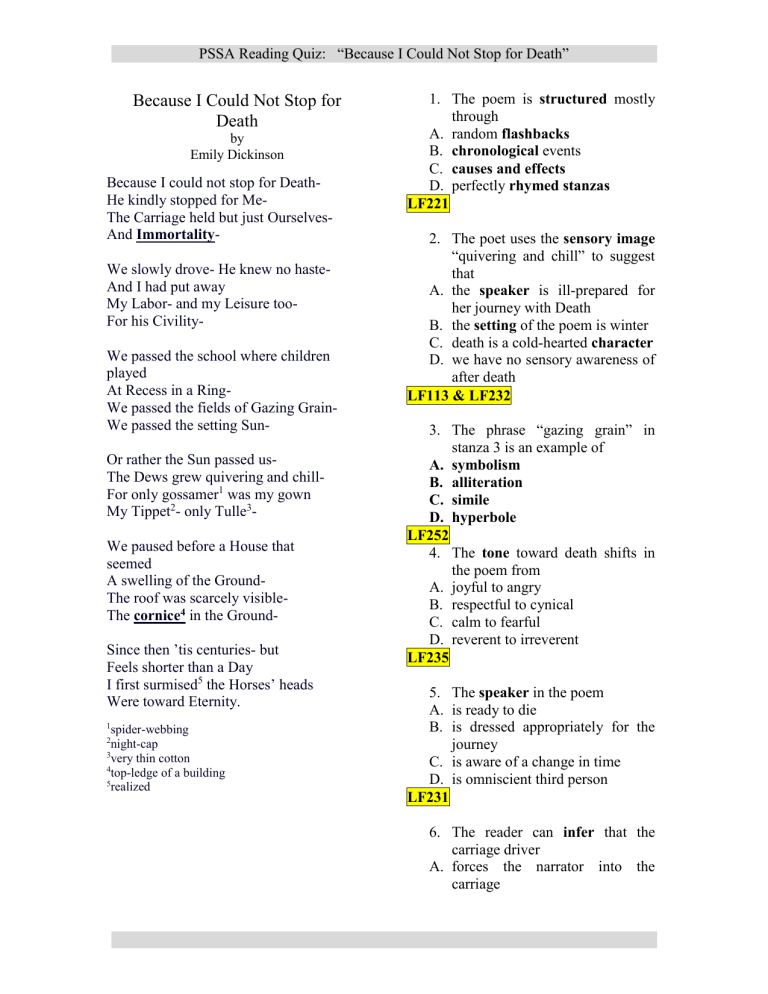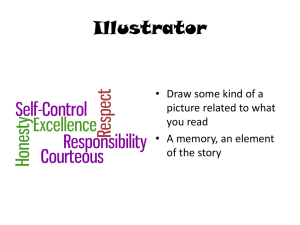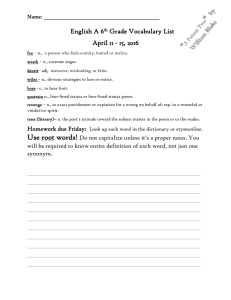Emily Dickinson Poetry Quiz: "Because I Could Not Stop for Death"
advertisement

PSSA Reading Quiz: “Because I Could Not Stop for Death” Because I Could Not Stop for Death by Emily Dickinson Because I could not stop for DeathHe kindly stopped for MeThe Carriage held but just OurselvesAnd ImmortalityWe slowly drove- He knew no hasteAnd I had put away My Labor- and my Leisure tooFor his CivilityWe passed the school where children played At Recess in a RingWe passed the fields of Gazing GrainWe passed the setting SunOr rather the Sun passed usThe Dews grew quivering and chillFor only gossamer1 was my gown My Tippet2- only Tulle3We paused before a House that seemed A swelling of the GroundThe roof was scarcely visibleThe cornice4 in the GroundSince then ’tis centuries- but Feels shorter than a Day I first surmised5 the Horses’ heads Were toward Eternity. 1 spider-webbing night-cap 3 very thin cotton 4 top-ledge of a building 5 realized 2 1. The poem is structured mostly through A. random flashbacks B. chronological events C. causes and effects D. perfectly rhymed stanzas LF221 2. The poet uses the sensory image “quivering and chill” to suggest that A. the speaker is ill-prepared for her journey with Death B. the setting of the poem is winter C. death is a cold-hearted character D. we have no sensory awareness of after death LF113 & LF232 3. The phrase “gazing grain” in stanza 3 is an example of A. symbolism B. alliteration C. simile D. hyperbole LF252 4. The tone toward death shifts in the poem from A. joyful to angry B. respectful to cynical C. calm to fearful D. reverent to irreverent LF235 5. The speaker in the poem A. is ready to die B. is dressed appropriately for the journey C. is aware of a change in time D. is omniscient third person LF231 6. The reader can infer that the carriage driver A. forces the narrator into the carriage PSSA Reading Quiz: “Because I Could Not Stop for Death” B. hurries to his destination C. is alone in the carriage with the narrator D. symbolizes death LF211 & LF251 7. The poet exercises poetic license by straying from the rules of Standard English with her unusual A. slang B. redundancy C. capitalization D. subject-verb agreement LF224 8. The word immortality comes from the Latin words im- and mortis, which must mean A. not moral B. not dead C. not alive D. not afraid LF122 9. To research what a cornice is, it would be best to consult which non-fictional text? A. Mortuary Science: An Annotated Bibliography B. The World Almanac C. Harmon’s Atlas of Cemeteries D. MacGruder’s Handbook of Architectural Terminology LF222 & LF123 10. The rhyme scheme of stanza 1 is A. AABB B. ABAC C. ABAB D. ABCB LF252



